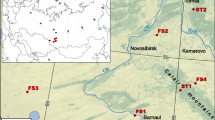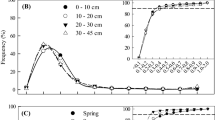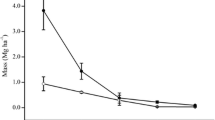Abstract
Key message
Fine root ingrowth and mortality of European beech are related to evapotranspiration, cumulative forest floor precipitation, soil temperature and water content, which are affected by forest management and gap creation.
Abstract
The ingrowth and mortality of European beech (Fagus sylvatica L.) fine roots (diameters <2 mm) were studied in relation to environmental variables describing temperature and water availability at four sites, covering a range in environmental conditions likely to be encountered in Slovenian beech forests. Minirhizotron images were used to determine fine root dynamics in a stand and gap in each of the sites for 12 periods during the 2007–2009 growing seasons. The environmental variables included air and soil temperatures, precipitation, forest floor precipitation, evapotranspiration and soil water contents. For data analysis, the daily mean values for each period for all variables were used. Fine root ingrowth and mortality were higher in the managed stand and gap compared to the old-growth stand and gap, but only significantly correlated with each other in the case of the managed stand. Forest floor precipitation and soil temperature were significant in explaining fine root ingrowth, whereas maximal evapotranspiration, soil temperature and soil water content were more important for fine root mortality. However, the correlations were weak and inconsistent among the four sites. By including site as predictor as well as environmental variables, R 2 values of 0.49 and 0.55 for ingrowth and mortality, respectively, were achieved. Despite this, the relationships between the fine root dynamics and selected environmental factors appeared relatively weak and complex, especially for fine root ingrowth and might be partially related also to differences in successional stages of the forests under study.


Similar content being viewed by others
References
Bolte A, Czajkowski T, Kompa T (2007) The north-eastern distribution range of European beech a review. Forestry 80:413–429. doi:10.1093/forestry/cpm028
Bončina A, Diaci J (1998) Contemporary research on regeneration patterns of Central European virgin forests with recommendation for future research. ZbGL 56:33–53
Børja I, De Wit HA, Steffenrem A, Majdi H (2008) Stand age and fine root biomass, distribution and morphology in a Norway spruce chronosequence in southeast Norway. Tree Physiol 28:773–784. doi:10.1093/treephys/28.5.773
Brunner I, Godbold DL (2007) Tree roots in a changing world. J For Res 12:78–82. doi:10.1007/s10310-006-0261-4
Campbell JJ, Finér L, Messier C (1998) Fine-root production in small experimental gaps in successional mixed boreal forests. J Veg Sci 9:537–542
Davi H, Dufrene E, Granier A, Le Dantec V, Barbaroux C, Francois C, Breda N (2005) Modelling carbon and water cycles in a beech forest: Part II: validation of the main processes from organ to stand scale. Ecol Model 185:387–405
Diaci J, Adamic T, Rozman A (2012) Gap recruitment and partitioning in an old-growth beech forest of the Dinaric Mountains: influences of light regime, herb competition and browsing. For Ecol Manage 285:20–28. doi:10.1016/j.foreco.2012.08.010
Dufrene E, Davi H, Francois C, Maire G, Dantec VL, Granier A (2005) Modelling carbon and water cycles in a beech forest: Part I: model description and uncertainty analysis on modelled NEE. Ecol Model 185:407–436
Federer CA (1995) BROOK90 Manual: a simulation model for evaporation, soil water and streamflow, Version 3.1. USDA Forest Service, Durham NH
Finér L, Messier C, De Grandpré L (1997) Fine-root dynamics in mixed boreal conifer—broad-leafed forest stands at different successional stages after fire. Can J For Res 27:304–314. doi:10.1139/x96-170
Finér L et al (2007) Variation in fine root biomass of three European tree species: Beech (Fagus sylvatica L.), Norway spruce (Picea abies L. Karst.), and Scots pine (Pinus sylvestris L.). Plant Biosyst Int J Dealing Asp Plant Biol 141(3):394–405
Finér L, Ohashi M, Noguchi K, Hirano Y (2011a) Factors causing variation in fine root biomass in forest ecosystems. For Ecol Manage 261:265–277. doi:10.1016/j.foreco.2010.10.016
Finér L, Ohashi M, Noguchi K, Hirano Y (2011b) Fine root production and turnover in forest ecosystems in relation to stand and environmental characteristics. For Ecol Manage 262:2008–2023. doi:10.1016/j.foreco.2011.08.042
Geßler A, Keitel C, Kreuzwieser J, Matyssek R, Seiler W, Rennenberg H (2007) Potential risks for European beech (Fagus sylvatica L.) in a changing climate. Trees 21:1–11. doi:10.1007/s00468-006-0107-x
Gill RA, Jackson RB (2000) Global patterns of root turnover for terrestrial ecosystems. New Phytol 147:13–31
GraphPad Software (2014) GraphPad Prism vol 1992-2014, 6.04 edn. Software MacKiev, La Jolla California, USA
Grebenc T, Christensen M, Vilhar U, Čater M, Martín MP, Simončič P, Kraigher H (2009) Response of ectomycorrhizal community structure to gap opening in natural and managed temperate beech-dominated forests. Can J For Res 39:1375–1386
Hammel K, Kennel M (2001) Charakterisierung und Analyse der Wasserverfügbarkeit und des Wasserhaushalts von Waldstandorten in Bayern mit dem Simulationsmodell BROOK90. Forstliche Forschungsberichte München, München
Hendrick R, Pregitzer K (1997) The relationship between fine root demography and the soil environment in northern hardwood forests. Ecoscience 4:99–105
Hertel D, Strecker T, Müller-Haubold H, Leuschner C (2013) Fine root biomass and dynamics in beech forests across a precipitation gradient—is optimal resource partitioning theory applicable to water-limited mature trees? J Ecol 101:1183–1200. doi:10.1111/1365-2745.12124
Joslin JD, Wolfe MH, Hanson PJ (2000) Effects of altered water regimes on forest root systems. New Phytol 147:117–129
Kaspar TC, Bland WL (1992) Soil temperature and root growth. Soil Sci 154:290–299
Knoke T, Seifert T (2008) Integrating selected ecological effects of mixed European beech—Norway spruce stands in bioeconomic modelling. Ecol Model 210:487–498. doi:10.1016/j.ecolmodel.2007.08.011
Kraigher H, Jurc D, Kalan P, Kutnar L, Levanič T, Rupel M, Smolej I (2002) Beech coarse woody debris characteristics in two virgin forest reserves in southern Slovenia. Zbornik gozdarstva in lesarstva 69:91–134
Kutnar L, Urbančič M (2006) Vpliv rastiščnih in sestojnih razmer na pestrost tal in vegetacije v izbranih bukovih in jelovo-bukovih gozdovih na Kočevskem. Influence of site and stand conditions on diversity of soil and vegetation in selected beech and fir-beech forests in the Kočevje region. ZbGL 80:3–30
Leuschner C, Hertel D, Schmid I, Koch O, Muhs A, Hölscher D (2004) Stand fine root biomass and fine root morphology in old-growth beech forests as a function of precipitation and soil fertility. Plant Soil 258:43–56
Leuschner C, Meier C, Hertel D (2006) On the niche breadth of Fagus sylvatica: soil nutrient status in 50 Central European beech stands on a broad range of bedrock types. Ann For Sci 63:355–368
Mainiero R, Kazda M (2006) Depth-related fine root dynamics of Fagus sylvatica during exceptional drought. For Ecol Manage 237:135–142
Mainiero R, Kazda M, Schmid I (2010) Fine root dynamics in 60-year-old stands of Fagus sylvatica and Picea abies growing on haplic luvisol soil. Eur J Forest Res 129:1001–1009. doi:10.1007/s10342-010-0383-2
Makkonen K, Helmisaari H-S (2001) Fine root biomass and production in Scots pine stands in relation to stand age. Tree Physiol 21:193–198
McCormack ML, Guo D (2014) Impacts of environmental factors on fine root lifespan. Front Plant Sci. doi:10.3389/fpls.2014.00205
Meier IC, Leuschner C (2008) Belowground drought response of European beech: fine root biomass and carbon partitioning in 14 mature stands across a precipitation gradient. Glob Change Biol 14:2081–2095
Montagnoli A, Di Iorio A, Terzaghi M, Trupiano D, Scippa GS, Chiatante D (2014) Influence of soil temperature and water content on fine-root seasonal growth of European beech natural forest in Southern Alps, Italy. Eur J For Res 133:957–968. doi:10.1007/s10342-014-0814-6
Morales P et al (2005) Comparing and evaluating process-based ecosystem model predictions of carbon and water fluxes in major European forest biomes. Global Change Biol 11:2211–2233
Pregitzer KS, King JS, Burton AJ, Brown SE (2000) Responses of tree fine roots to temperature. New Phytol 147:105–115
R Development Core Team (2013) R: a language and environment for statistical computing. R Foundation for statistical computing. http://www.R-project.org/
Ritter E (2005) Litter decomposition and nitrogen mineralization in newly formed gaps in a Danish beech (Fagus sylvatica) forest. Soil Biol Biochem 37:1237–1247. doi:10.1016/j.soilbio.2004.11.020
Ritter E, Dalsgaard L, Einhorn KS (2005) Light, temperature and soil moisture regimes following gap formation in a semi-natural beech-dominated forest in Denmark. For Ecol Manage 206:15–33. doi:10.1016/j.foreco.2004.08.011
Shuttleworth WJ, Wallace JS (1985) Evaporation from sparse crops—an energy combination theory. Quart J Royal meteorol Soc 111:839–855
Stojanović DB et al (2013) Prediction of the European beech (Fagus sylvatica L.) xeric limit using a regional climate model: an example from southeast Europe. Agric For Meteorol 176:94–103. doi:10.1016/j.agrformet.2013.03.009
Štraus I, Mrak T, Ferlan M, Železnik P, Kraigher H (2014) Influence of soil temperature on growth traits of European beech seedlings. Can J For Res. doi:10.1139/cjfr-2014-0332
Sun T, Dong L, Mao Z, Li Y (2015) Fine root dynamics of trees and understorey vegetation in a chronosequence of Betula platyphylla stands. For Ecol Manage 346:1–9. doi:10.1016/j.foreco.2015.02.035
Tierney GL, Fahey TJ, Groffman PM, Hardy JP, Fitzhugh RD, Driscoll CT, Yavitt JB (2003) Environmental control of fine root dynamics in a northern hardwood forest. Glob Change Biol 9:670–679
Urbančič M et al (2005). Impacts of Gaps on Humus Forms in Dinaric Silver Fir-Beech Forest (Omphalodo- Fagetum) and Soil Solution Quality. Mitt der Österr Bodenkd Ges 72:179–187.
Vilhar U, Simončič P (2012) Water status and drought stress after gap formation in managed and semi-natural silver fir—beech forests Eur. J For Res 131:1381–1397. doi:10.1007/s10342-012-0605-x
Vilhar U, Simončič P, Kajfež-Bogataj L, Katzensteiner K, Diaci J (2006) Mikroklimatske razmere v vrzelih in sestojih dinarskega jelovo-bukovega gozda. Microclimate conditions in gaps and mature stands of Dinaric silver fir-beech forests. ZbGL 81:21–36
Vilhar U, Starr M, Katzensteiner K, Simončič P, Kajfež-Bogataj L, Diaci J (2010) Modelling drainage fluxes in managed and natural forests in the Dinaric karst: a model comparison study. Eur J For Res 129:729–740. doi:10.1007/s10342-010-0379-y
Vilhar U, Roženbergar D, Simončič P, Diaci J (2015) Variation in irradiance, soil features and regeneration patterns in experimental forest canopy gaps. Ann For Sci 72:253–266. doi:10.1007/s13595-014-0424-y
Vogt KA, Vogt DJ, Moore EE, Fatuga BA, Redlin MR, Edmonds RL (1987) Conifer and angiosperm fine-root biomass in relation to stand age and site productivity in Douglas-fir forests. J Ecol 75:857–870. doi:10.2307/2260210
Vogt KA, Vogt DJ, Palmiotto PA, Boon P, O’Hara J, Asbjornsen H (1996) Review of root dynamics in forest ecosystems grouped by climate, climatic forest type and species. Plant Soil 187:159–219. doi:10.1007/bf00017088
Yuan ZY, Chen HYH (2012) Fine root dynamics with stand development in the boreal forest. Funct Ecol 26:991–998. doi:10.1111/j.1365-2435.2012.02007.x
Author contribution statement
Peter Železnik: data collection; paper concept and approach; drafting of text; revision and editing. Urša Vilhar: modelling; paper concept and approach; drafting of text, graphs and tables; revision and editing. Mike Starr: paper concept and approach; checking of data; drafting of text, graphs and tables; revision and editing. Maarten de Groot: statistical analysis; paper concept and approach; partial drafting of text, graphs and tables. Hojka Kraigher: research project preparation and management; supervision of Ph.D. thesis.
Acknowledgments
The study was part of a Ph.D. study, the 5th EU FP project Nature-Based Management of Beech in Europe (NAT-MAN 648 QLK-CT99-1349), ManFor C. BD project, titled “Managing forests for 649 multiple purposes: carbon, biodiversity and socio-economic wellbeing” (LIFE09ENV/IT/000078), EUFORINNO—“European Forest Research and Innovation” (Reg. Pot No. 315982), several projects within the Programme group “Forest biology, ecology and technology”, and finalized within the project “Carbon dynamics in forest soils and the rhizosphere” financed by the Ministry of Education, Science and Sport of the Republic of Slovenia. We would also like to thank the anonymous reviewers for their constructive comments.
Conflict of interest
The authors declare they have no conflict of interest.
Author information
Authors and Affiliations
Corresponding author
Additional information
Communicated by T. Koike and K. Noguchi.
P. Železnik, U. Vilhar and M. Starr have contributed equally to the article.
Electronic supplementary material
Below is the link to the electronic supplementary material.
Rights and permissions
About this article
Cite this article
Železnik, P., Vilhar, U., Starr, M. et al. Fine root dynamics in Slovenian beech forests in relation to soil temperature and water availability. Trees 30, 375–384 (2016). https://doi.org/10.1007/s00468-015-1218-z
Received:
Revised:
Accepted:
Published:
Issue Date:
DOI: https://doi.org/10.1007/s00468-015-1218-z




